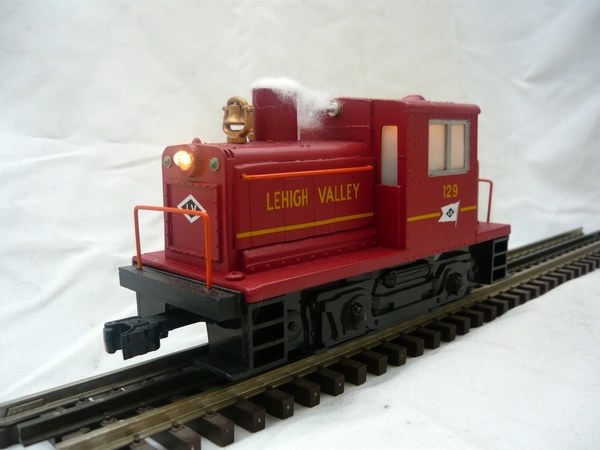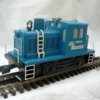redrockbill, sounds to me like you're referencing some variation of the Lionel Industrial Switcher. If it is one of the early DC model versions with the "Hustler" motor, it might not be worth the effort as parts for that one are hard to come by. The later version introduced around 1993 is a much better model.
First off, you need a glossy surface for decals to properly adhere to. So you want to wash the loco shell thoroughly in warm soapy water to get any grease off the shell, which will interfere with paint adhesion. Obviously remove any headlight lens, etc. that you don't want to be painted. Use a plastic safe primer paint first and do the whole shell inside and out. Testors paints are slow drying so I prefer Krylon, though that is now becoming harder to find. Many spray paints now claim to be plastic safe. Years ago Rustoleum was one of the questionable brands in this regard (see PC photo below), but if you use a plastic safe primer first with complete coverage, you can then use something like the Rustoleum. Though as I said, Rustoleum is now made in plastic safe spray cans.
Also, clean the spray paint nozzle after every usage with isopropyl alcohol to prevent clogging.
I would search to see if any decal maker has any Ford logos. I've had less than desired results making decals on a laser jet printer. And in order to get white print, you need the white decal stock, by which you print the background color around your desired decal logo and print. On the upside there, black is certainly the easiest color to match.
Once you have your project complete, you then can use a matt surface clear spray to seal everything and help to hide any decal lines. I no longer prefer Testors Dull Coat as it yellows over time... you really notice that on something that is painted white in color.
There's a lot more I could say here: I've been repainting now for 32 years, using spray cans and also working outdoors. Yes, that is possible even in cooler temperatures... Use a cardboard box and one of the cheap plastic "lazy susan" plate spinners. Spray on a quick coat and then bring it quickly inside to dry.
Also, though you didn't mention it, yellow and orange colors are tough to get good opaque coverage and require multiple coats. I prefer to use grey primer to lose any translucent effect, especially on illuminated train items. But if the color is going to be yellow or orange, I will often spray on a quick coat of white primer over the grey to help with the process.
A few photos. First is a K-Line Alco FA. Rustoleum made a color some years ago that was by my viewing, very close to the correct PC green. The paint wasn't labeled as plastic safe, but the other coatings I used were. I also use regular masking tape, but a more premium type that will have sharper edges. Put on the tape and then "seal it" with a quick coat of the older base color, before putting on your new color.
The next couple photos are Lionel Industrial switchers I've repainted. If this is indeed your project engine, the circuit board reverse unit is held in the loco via a thick piece of self-adhesive foam tape, which you will need to remove completely. For me, I remove the board and run my locos on DC current. Not having the board gives me more room to add weights inside the loco shell. My switchers can easily pull more than 10 train cars with ease: Out of the box as is, they can't do that.








